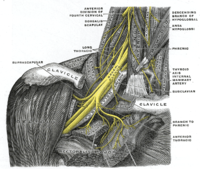
Photo from wikipedia
Background: Isolated lower (C8T1) brachial plexus injury (BPI) is uncommon and the aim of treatment is to achieve a satisfactory grasp enabling the use of the hand for daily activities.… Click to show full abstract
Background: Isolated lower (C8T1) brachial plexus injury (BPI) is uncommon and the aim of treatment is to achieve a satisfactory grasp enabling the use of the hand for daily activities. The aim of this study is to report the outcomes of the transfer of brachioradialis (BR) to flexor pollicis longus (FPL) and biceps to the flexor digitorum profundus (FDP) for an isolated lower BPI. Methods: This is a retrospective study of all patients with an isolated lower BPI who underwent a BR to FPL and biceps to FDP transfer for restoration of digital flexion over a 1-year period from May 2019 to June 2020. Patient demographic and injury data were collected at the presentation. Outcomes data included the ability to grasp and perform activities of daily living and DASH score. Results: The study included three patients (all men) with an average age of 30.3 years. All sustained an isolated lower BPI following a road traffic accident and tendon transfers were performed at a mean of 9.3 months after the initial injury. At a mean of 1-year follow-up, all three recovered grade M4 motor power of digital flexion, achieved good grasp function with pulp-to-palm distance of <1 cm. All are able to use the hand for independent as well as bimanual activities. The individual DASH scores were 36, 30 and 30. Conclusions: BR to FPL for thumb flexion and biceps to FDP using fascia lata graft to restore finger flexion is simple and effective surgeries in patients with isolated lower BPI. Level of Evidence: Level V (Therapeutic).
Journal Title: The journal of hand surgery Asian-Pacific volume
Year Published: 2022
Link to full text (if available)
Share on Social Media: Sign Up to like & get
recommendations!